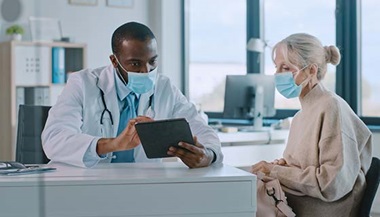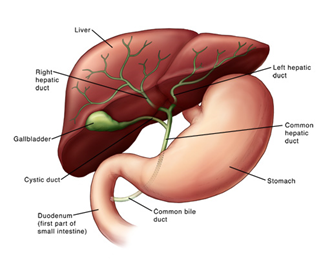Cholecystitis
What is cholecystitis?
Cholecystitis (pronounced ko-luh-sis-TIE-tis) is a redness and swelling (inflammation) of the gallbladder. It happens when a digestive juice called bile gets trapped in your gallbladder.
The gallbladder is a small organ under your liver. It stores bile which is made in the liver.
Normally bile drains out of your gallbladder and into your small intestine. If the bile is blocked, it builds up in your gallbladder. This causes inflammation and can cause infection.
Cholecystitis can be sudden (acute) or long-term (chronic).
What causes cholecystitis?
Cholecystitis happens when a digestive juice called bile gets trapped in your gallbladder.
In most cases, this happens because lumps of solid material (gallstones) are blocking a tube that drains bile from the gallbladder.
When gallstones block this tube, bile builds up in your gallbladder. This causes irritation and pressure in the gallbladder. It can cause swelling and infection.
The gallbladder stores bile. Gallstones are formed in your gallbladder. They are made from bile.
Other causes of cholecystitis include:
- Bacterial infection in the bile duct system. The bile duct system is the drainage system that carries bile from your liver and gallbladder into the first part of your small intestine (the duodenum).
- Tumors of the pancreas or liver. A tumor can stop bile from draining out of your gallbladder.
- Reduced blood supply to the gallbladder. This may happen if you have diabetes.
- Gallbladder sludge. This is a thick material that can’t be absorbed by bile in your gallbladder. The sludge builds up in your gallbladder. It happens mainly to pregnant women or to people who have had a very fast weight loss.
Cholecystitis can happen suddenly (acute) or it can be long-term (chronic).
What are the symptoms of cholecystitis?
In most cases, an attack of cholecystitis lasts 2 to 3 days. Each person’s symptoms may vary. Symptoms may include:
- Intense, sudden pain in the upper right part of your belly
- Pain (often worse with deep breaths) that spreads to your back or below the right shoulder blade
- Nausea
- Vomiting
- Fever
- Yellowing of the skin and eyes (jaundice)
- Loose, light-colored bowel movements
- Belly bloating
The symptoms of cholecystitis may look like other health problems. Always see your healthcare provider to be sure.
How is cholecystitis diagnosed?
Your healthcare provider will look at your past health and give you a physical exam.
You may also have some blood tests including:
- Complete blood count (CBC). This test measures your white blood cell count. You may have a high white blood cell count if you have an infection.
- Liver function tests. A group of special blood tests that can tell if your liver is working properly.
You may also have imaging tests, including:
- Ultrasound (also called sonography). This test creates images of your internal organs on a computer screen using high-frequency sound waves. It is used to see the liver and gallbladder and check blood flow through different vessels.
- Belly X-ray. This test makes pictures of internal tissues, bones, and organs using invisible electromagnetic energy beams.
- CT scan. This is an imaging test that uses X-rays and a computer to make detailed images of the body. A CT scan shows details of the bones, muscles, fat, and organs. It is more detailed than a regular X-ray.
- HIDA scan (cholescintigraphy or hepatobiliary scintigraphy). This scan checks for any abnormal movements (contractions) of your gallbladder. It also checks for blocked bile ducts. A radioactive chemical or tracer is shot (injected) into your vein. The amount of radiation is very small. It is not harmful. It collects in your liver and flows into your gallbladder. A special scanner watches the tracer move through your organs. You will take medicine to make your gallbladder contract.
- PTC (percutaneous transhepatic cholangiography). A thin needle is put through your skin and into the bile duct in your liver. A dye is then shot (injected) through the needle. The dye lets your bile ducts be seen clearly on the X-rays. A blocked duct will show up on the X-rays.
- ERCP (endoscopic retrograde cholangiopancreatography. This is used to find and treat problems in your liver, gallbladder, bile ducts, and pancreas. It uses X-ray and a long, flexible tube (endoscope) with a light and camera at one end. The tube is put into your mouth and throat. It goes down your food pipe (esophagus), through your stomach, and into the first part of your small intestine (the duodenum). It then goes into your bile ducts. The inside of these organs can be seen on a video screen. A dye is put into your bile ducts through the tube. The dye lets the bile ducts be seen clearly on the X-rays.
How is cholecystitis treated?
You will likely be admitted to a hospital to rest your gallbladder. You may need surgery to remove your gallbladder.
In the hospital your treatment may include:
- Taking bacteria-fighting medicines (antibiotics) to fight the infection
- Taking fluids and pain medicines by IV (through a vein or intravenously)
- Keeping your stomach empty until your symptoms ease
Your symptoms may get better with this treatment.
But if your cholecystitis is caused by gallstones in your gallbladder, your gallbladder will need to be removed. Gallbladder removal (called cholecystectomy) is a common surgery. Your body will work well without your gallbladder. It is not essential for a healthy life.
You may have surgery done right away. If you are too sick to have surgery, a small tube may be put through your skin and into your gallbladder. This will drain the bile and ease your symptoms until you can have surgery.
Other treatment options may include:
- Oral dissolution therapy. Medicines made from bile acid are used to dissolve the stones
- Medicines. These are used to prevent gallstones from forming
- Low-fat diet. When you are allowed to eat food again
What are the complications of cholecystitis?
In some cases cholecystitis can cause other problems including:
- Infection and pus buildup in your gallbladder
- Tissue death in your gallbladder (gangrene)
- Bile duct injury that can affect your liver
- Infection and inflammation of your pancreas (pancreatitis)
- Infection and inflammation of the lining of your belly (peritonitis)
If your gallbladder has not been removed and you have more attacks of cholecystitis, you may develop long-term (chronic) cholecystitis.
Chronic cholecystitis may not cause any symptoms. But it can damage the walls of your gallbladder. The walls can become scarred and get thicker. Your gallbladder will start to get smaller. Over time, it will be less able to store and release bile. You will need surgery to remove your gallbladder.
When should I call my healthcare provider?
Call your healthcare provider right away if:
- You have severe belly pain that won’t go away
- Your cholecystitis symptoms come back after treatment
Key points about cholecystitis
- Cholecystitis is a redness and swelling (inflammation) of the gallbladder.
- It happens when bile becomes trapped and builds up in the gallbladder.
- In most cases this happens when solid lumps (gallstones) block the tube that drains bile from the gallbladder.
- In most cases you will be admitted to a hospital.
- Your gallbladder may need to be removed.
Next steps
Tips to help you get the most from a visit to your healthcare provider:- Know the reason for your visit and what you want to happen.
- Before your visit, write down questions you want answered.
- Bring someone with you to help you ask questions and remember what your provider tells you.
- At the visit, write down the name of a new diagnosis, and any new medicines, treatments, or tests. Also write down any new instructions your provider gives you.
- Know why a new medicine or treatment is prescribed, and how it will help you. Also know what the side effects are.
- Ask if your condition can be treated in other ways.
- Know why a test or procedure is recommended and what the results could mean.
- Know what to expect if you do not take the medicine or have the test or procedure.
- If you have a follow-up appointment, write down the date, time, and purpose for that visit.
- Know how you can contact your provider if you have questions.





